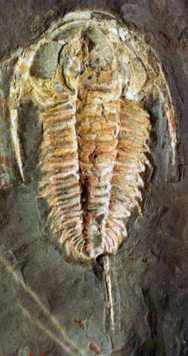Genus is a taxonomic rank used in the biological classification of living and fossil organisms as well as viruses. In the hierarchy of biological classification, genus comes above species and below family. In binomial nomenclature, the genus name forms the first part of the binomial species name for each species within the genus.

In meteorology, a cloud is an aerosol consisting of a visible mass of miniature liquid droplets, frozen crystals, or other particles suspended in the atmosphere of a planetary body or similar space. Water or various other chemicals may compose the droplets and crystals. On Earth, clouds are formed as a result of saturation of the air when it is cooled to its dew point, or when it gains sufficient moisture from an adjacent source to raise the dew point to the ambient temperature.

The International Code of Zoological Nomenclature (ICZN) is a widely accepted convention in zoology that rules the formal scientific naming of organisms treated as animals. It is also informally known as the ICZN Code, for its publisher, the International Commission on Zoological Nomenclature. The rules principally regulate:

In zoological nomenclature, a type species is the species name with which the name of a genus or subgenus is considered to be permanently taxonomically associated, i.e., the species that contains the biological type specimen. A similar concept is used for suprageneric groups and called a type genus.

In biology, a type is a particular specimen of an organism to which the scientific name of that organism is formally associated. In other words, a type is an example that serves to anchor or centralizes the defining features of that particular taxon. In older usage, a type was a taxon rather than a specimen.

The Nitrosomonadales are an order of the class Betaproteobacteria in the phylum "Pseudomonadota". Like all members of their class, they are Gram-negative.

In biological taxonomy, the type genus is the genus which defines a biological family and the root of the family name.

Olenellus is an extinct genus of redlichiid trilobites, with species of average size. It lived during the Botomian and Toyonian stages (Olenellus-zone), 522 to 510 million years ago, in what is currently North-America, part of the palaeocontinent Laurentia.

Redlichia takooensis is a species of redlichiid trilobite from the lower Cambrian-aged Emu Shale of Kangaroo Island, Australia.

Redlichiina is a suborder of the order Redlichiida of Trilobites. The suborder contains three superfamilies: Emuelloidea, Redlichioidea and Paradoxidoidea. These trilobites are some of the oldest trilobites known. They originated at the beginning of the Cambrian Period and disappeared at the end of the middle Cambrian.

Redlichia is a genus of redlichiid trilobite in the family Redlichiidae, with large to very large species. Fossils of various species are found in Lower Cambrian (Toyonian)-aged marine strata from China, Korea, Pakistan, the Himalayas, Iran, Spain, southern Siberia, and Antarctica, and from Middle Cambrian (Ordian)-aged marine strata of Australia.

The Emu Bay Shale is a geological formation in Emu Bay, South Australia, containing a major Konservat-Lagerstätte. It is one of two in the world containing Redlichiidan trilobites. The Emu Bay Shale is dated as Cambrian Series 2, Stage 4, correlated with the upper Botomian Stage of the Lower Cambrian.

Acacia, commonly known as the wattles or acacias, is a large genus of shrubs and trees in the subfamily Mimosoideae of the pea family Fabaceae. Initially, it comprised a group of plant species native to Africa and Australasia. The genus name is Neo-Latin, borrowed from the Greek ἀκακία, a term used by Dioscorides for a preparation extracted from the leaves and fruit pods of Vachellia nilotica, the original type of the genus. In his Pinax (1623), Gaspard Bauhin mentioned the Greek ἀκακία from Dioscorides as the origin of the Latin name.
The Botanical and Zoological Codes of nomenclature treat the concept of synonymy differently.

Holyoakia is a genus of very small trilobites of the family Dorypygidae, from the late Lower Cambrian of South Australia and Antarctica.

Panlongia was a small-sized marine arthropod, with an oval-shaped non-calcified exoskeleton. Both the head shield and the tail shield are semi-circular. In between the cephalon and pygidium are four thoracic body segments (somites). The cephalon occupies approximately ⅓ of the body length, the thorax ¼ and pygidium about 45%. Panlongia lived during the late Lower Cambrian (Botomian) in what is today South China. In Panlongia spinosa the edge of the exoskeleton carries several small sawtooth-like spines, that are absent in P. tetranodusa.

Salterella is an enigmatic Cambrian genus with a small, conical, calcareous shell that appears to be septate, but is rather filled with stratified laminar deposits. The shell contains grains of sediment, which are obtained selectively by a manner also observed in foramanifera. The genus was established by Elkanah Billings in 1861, and was named after the English palaeontologist John William Salter.

Eoredlichia is an extinct genus of trilobite of average to large size. It lived during the early Cambrian in the Chengjiang fauna of Yunnan, China, and in Australia and Thailand. Eoredlichia is compounded of the Greek ἠώς and Redlichia, a later but related genus, so it means "early Redlichia". The species epithet intermedia means intermediate, indicating it is morphologically intermediate between other species. Eofallotaspis gives rise to Lemdadella, and thence to Eoredlichia and the other Redlichiidae.
Cambrian Stage 4 is the still unnamed fourth stage of the Cambrian and the upper stage of Cambrian Series 2. It follows Cambrian Stage 3 and lies below the Wuliuan. The lower boundary has not been formally defined by the International Commission on Stratigraphy. One proposal is the first appearance of two trilobite genera, Olenellus or Redlichia. Another proposal is the first appearance of the trilobite species Arthricocephalus chauveaui. Both proposals will set the lower boundary close to 514 million years ago. The upper boundary corresponds to the beginning of the Wuliuan.

Redlichia chinensis is an extinct species of trilobite that existed from 526 million years ago to 513 million years ago in the early Cambrian period.















